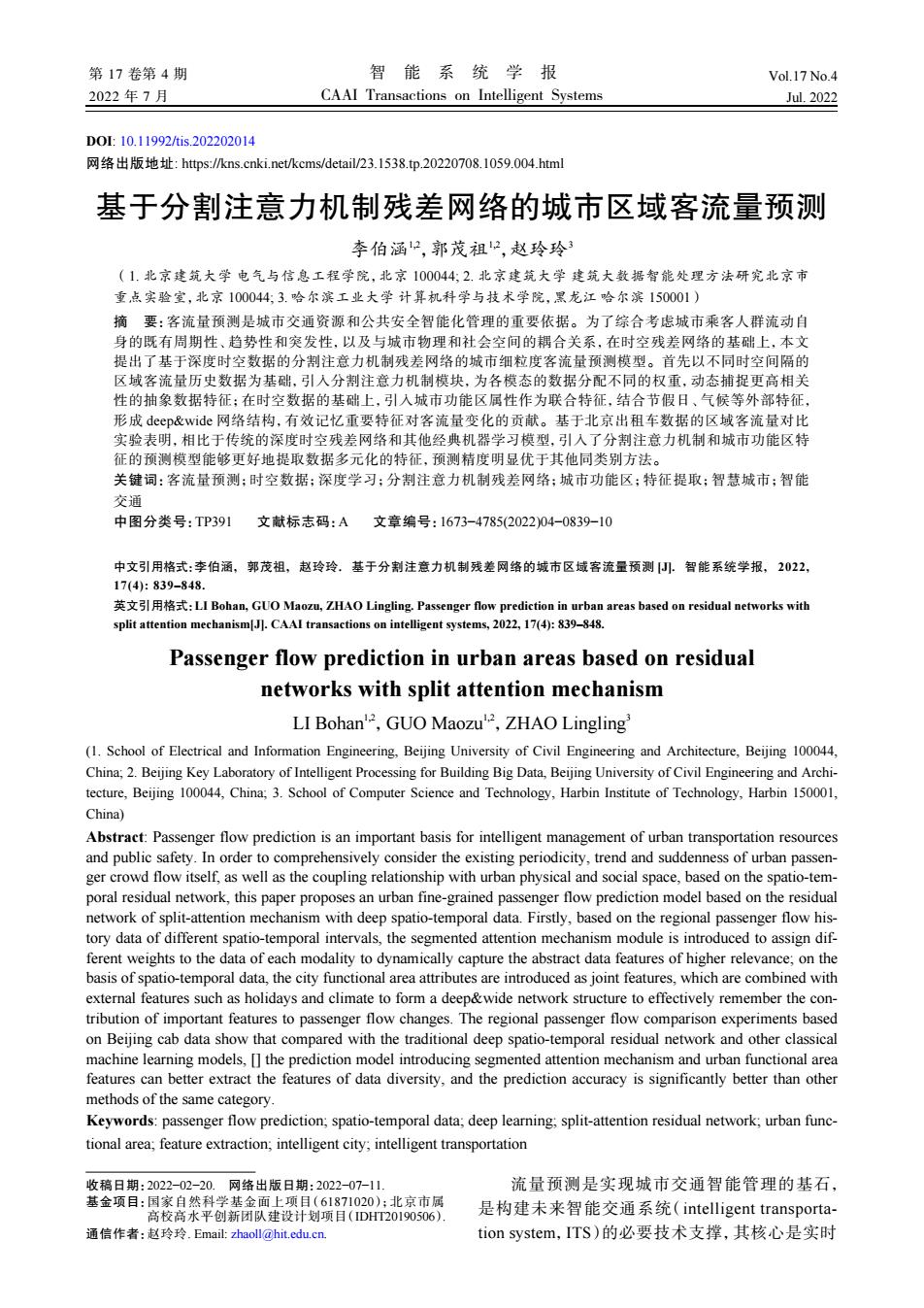正在加载图片...

第17卷第4期 智能系统学报 Vol.17 No.4 2022年7月 CAAI Transactions on Intelligent Systems Jul.2022 D0:10.11992/tis.202202014 网络出版地址:https:/kns.cnki.net/kcms/detail/23.1538.tp.20220708.1059.004.html 基于分割注意力机制残差网络的城市区域客流量预测 李伯涵2,郭茂祖2,赵玲玲3 (1.北京建筑大学电气与信息工程学院,北京100044,2.北京建筑大学建筑大数据智能处理方法研究北京市 重点实验室,北京100044,3.哈尔滨工业大学计算机科学与技术学院,黑龙江哈尔滨150001) 摘要:客流量预测是城市交通资源和公共安全智能化管理的重要依据。为了综合考虑城市乘客人群流动自 身的既有周期性、趋势性和突发性,以及与城市物理和社会空间的耦合关系,在时空残差网络的基础上,本文 提出了基于深度时空数据的分割注意力机制残差网络的城市细粒度客流量预测模型。首先以不同时空间隔的 区域客流量历史数据为基础,引入分割注意力机制模块,为各模态的数据分配不同的权重,动态捕捉更高相关 性的抽象数据特征:在时空数据的基础上,引入城市功能区属性作为联合特征,结合节假日、气候等外部特征, 形成deep&wide网络结构,有效记忆重要特征对客流量变化的贡献。基于北京出租车数据的区域客流量对比 实验表明,相比于传统的深度时空残差网络和其他经典机器学习模型,引入了分割注意力机制和城市功能区特 征的预测模型能够更好地提取数据多元化的特征,预测精度明显优于其他同类别方法。 关键词:客流量预测:时空数据;深度学习;分割注意力机制残差网络:城市功能区;特征提取;智慧城市;智能 交通 中图分类号:TP391 文献标志码:A文章编号:1673-4785(2022)04-0839-10 中文引用格式:李伯涵,郭茂祖,赵玲玲.基于分割注意力机制残差网络的城市区域客流量预测.智能系统学报,2022, 17(4):839-848. 英文引用格式:LI Bohan,GUO Maozu,ZHAO Lingling.Passenger flow prediction in urban areas based on residual networks with split attention mechanism[J.CAAI transactions on intelligent systems,2022,17(4):839-848. Passenger flow prediction in urban areas based on residual networks with split attention mechanism LI Bohan2,GUO Maozu,ZHAO Lingling (1.School of Electrical and Information Engineering,Beijing University of Civil Engineering and Architecture,Beijing 100044, China;2.Beijing Key Laboratory of Intelligent Processing for Building Big Data,Beijing University of Civil Engineering and Archi- tecture,Beijing 100044,China;3.School of Computer Science and Technology,Harbin Institute of Technology,Harbin 150001, China) Abstract:Passenger flow prediction is an important basis for intelligent management of urban transportation resources and public safety.In order to comprehensively consider the existing periodicity,trend and suddenness of urban passen- ger crowd flow itself,as well as the coupling relationship with urban physical and social space,based on the spatio-tem- poral residual network,this paper proposes an urban fine-grained passenger flow prediction model based on the residual network of split-attention mechanism with deep spatio-temporal data.Firstly,based on the regional passenger flow his- tory data of different spatio-temporal intervals,the segmented attention mechanism module is introduced to assign dif- ferent weights to the data of each modality to dynamically capture the abstract data features of higher relevance;on the basis of spatio-temporal data,the city functional area attributes are introduced as joint features,which are combined with external features such as holidays and climate to form a deep&wide network structure to effectively remember the con- tribution of important features to passenger flow changes.The regional passenger flow comparison experiments based on Beijing cab data show that compared with the traditional deep spatio-temporal residual network and other classical machine learning models,[the prediction model introducing segmented attention mechanism and urban functional area features can better extract the features of data diversity,and the prediction accuracy is significantly better than other methods of the same category. Keywords:passenger flow prediction;spatio-temporal data;deep learning;split-attention residual network;urban func- tional area:feature extraction;intelligent city;intelligent transportation 收稿日期:2022-02-20.网络出版日期:2022-07-11 流量预测是实现城市交通智能管理的基石, 基金项目:国家自然科学基金面上项目(61871020):北京市属 高校高水平创新团队建设计划项目(IDHT20190506). 是构建未来智能交通系统(intelligent transporta- 通信作者:赵玲玲.Email:zhaoll@hit.edu.cn. tion system,ITS)的必要技术支撑,其核心是实时DOI: 10.11992/tis.202202014 网络出版地址: https://kns.cnki.net/kcms/detail/23.1538.tp.20220708.1059.004.html 基于分割注意力机制残差网络的城市区域客流量预测 李伯涵1,2,郭茂祖1,2,赵玲玲3 (1. 北京建筑大学 电气与信息工程学院,北京 100044; 2. 北京建筑大学 建筑大数据智能处理方法研究北京市 重点实验室,北京 100044; 3. 哈尔滨工业大学 计算机科学与技术学院,黑龙江 哈尔滨 150001) 摘 要:客流量预测是城市交通资源和公共安全智能化管理的重要依据。为了综合考虑城市乘客人群流动自 身的既有周期性、趋势性和突发性,以及与城市物理和社会空间的耦合关系,在时空残差网络的基础上,本文 提出了基于深度时空数据的分割注意力机制残差网络的城市细粒度客流量预测模型。首先以不同时空间隔的 区域客流量历史数据为基础,引入分割注意力机制模块,为各模态的数据分配不同的权重,动态捕捉更高相关 性的抽象数据特征;在时空数据的基础上,引入城市功能区属性作为联合特征,结合节假日、气候等外部特征, 形成 deep&wide 网络结构,有效记忆重要特征对客流量变化的贡献。基于北京出租车数据的区域客流量对比 实验表明,相比于传统的深度时空残差网络和其他经典机器学习模型,引入了分割注意力机制和城市功能区特 征的预测模型能够更好地提取数据多元化的特征,预测精度明显优于其他同类别方法。 关键词:客流量预测;时空数据;深度学习;分割注意力机制残差网络;城市功能区;特征提取;智慧城市;智能 交通 中图分类号:TP391 文献标志码:A 文章编号:1673−4785(2022)04−0839−10 中文引用格式:李伯涵, 郭茂祖, 赵玲玲. 基于分割注意力机制残差网络的城市区域客流量预测 [J]. 智能系统学报, 2022, 17(4): 839–848. 英文引用格式:LI Bohan, GUO Maozu, ZHAO Lingling. Passenger flow prediction in urban areas based on residual networks with split attention mechanism[J]. CAAI transactions on intelligent systems, 2022, 17(4): 839–848. Passenger flow prediction in urban areas based on residual networks with split attention mechanism LI Bohan1,2 ,GUO Maozu1,2 ,ZHAO Lingling3 (1. School of Electrical and Information Engineering, Beijing University of Civil Engineering and Architecture, Beijing 100044, China; 2. Beijing Key Laboratory of Intelligent Processing for Building Big Data, Beijing University of Civil Engineering and Architecture, Beijing 100044, China; 3. School of Computer Science and Technology, Harbin Institute of Technology, Harbin 150001, China) Abstract: Passenger flow prediction is an important basis for intelligent management of urban transportation resources and public safety. In order to comprehensively consider the existing periodicity, trend and suddenness of urban passenger crowd flow itself, as well as the coupling relationship with urban physical and social space, based on the spatio-temporal residual network, this paper proposes an urban fine-grained passenger flow prediction model based on the residual network of split-attention mechanism with deep spatio-temporal data. Firstly, based on the regional passenger flow history data of different spatio-temporal intervals, the segmented attention mechanism module is introduced to assign different weights to the data of each modality to dynamically capture the abstract data features of higher relevance; on the basis of spatio-temporal data, the city functional area attributes are introduced as joint features, which are combined with external features such as holidays and climate to form a deep&wide network structure to effectively remember the contribution of important features to passenger flow changes. The regional passenger flow comparison experiments based on Beijing cab data show that compared with the traditional deep spatio-temporal residual network and other classical machine learning models, [] the prediction model introducing segmented attention mechanism and urban functional area features can better extract the features of data diversity, and the prediction accuracy is significantly better than other methods of the same category. Keywords: passenger flow prediction; spatio-temporal data; deep learning; split-attention residual network; urban functional area; feature extraction; intelligent city; intelligent transportation 流量预测是实现城市交通智能管理的基石, 是构建未来智能交通系统(intelligent transportation system,ITS)的必要技术支撑,其核心是实时 收稿日期:2022−02−20. 网络出版日期:2022−07−11. 基金项目:国家自然科学基金面上项目(61871020);北京市属 高校高水平创新团队建设计划项目(IDHT20190506). 通信作者:赵玲玲. Email: zhaoll@hit.edu.cn. 第 17 卷第 4 期 智 能 系 统 学 报 Vol.17 No.4 2022 年 7 月 CAAI Transactions on Intelligent Systems Jul. 2022